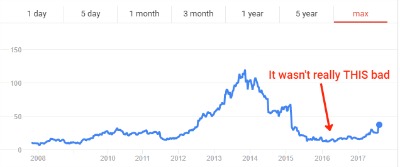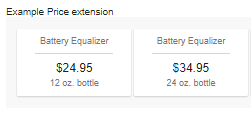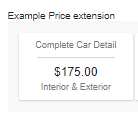AdWords’ Price Extensions: 5 Powerful Techniques You Can Use
In the past when we’ve talked about pricing strategies in digital marketing, it’s mostly been a conversation about post-click conversion rate optimization. Sure, we’ve always been able to put prices in ad text. But with the release of 2 newer ad extensions in Google AdWords (and the presence of product listing ads), it’s becoming more and more of a pre-click conversation as time goes on.
Part of what makes us human
When you get to Marketing 201, you learn that buyers make emotional decisions when it comes to purchasing, and then use rationale to justify their behavior after their emotions have influenced them one way or the other.
 This emotional piece is of course part of what makes us humans and not robots.
This emotional piece is of course part of what makes us humans and not robots.
In a recent book I read called Misbehaving: The Making of Behavioral Economics, the famed economist Richard Thaler talks about the differences in behaviors that behavioral economists are learning because of human emotion. He calls what a human would be without any emotion an “econ.” (instead of a robot). An econ is a being that would make decisions simply based on choosing the best logical choice given all the available information.
Throughout the book, he goes through study after study of scenarios and points out the differences between what a econ would do versus what humans tend to do because they’re emotional creatures.
An emotional example
There may be no better example of this than the stock market. Sometimes businesses are priced what they’re worth, but many times they’re priced far below or far above what they’re worth. Why? People get emotional.
Did you know that Yahoo! once sold on the stock market for a price that was over 100x its earnings?!? The average company sells for 15-20x earnings. We know how that one turned out. On the flip side, one solid company I recently invested in had a price of $120 per share just 3 1/2 years ago. It then went through some negative PR and definitely paid the price for it in sales. So the stock price went down, and rightfully so. An econ would lower the price it’s willing to pay for sure after an event like this. But if you knew the company and the chances that it would make it through, you would know there was no way the price should have been lowered to $15 (like it was)!
Now there’s no doubt the company faced tough times ahead and for sure there was risk involved as they navigated their way through a tough situation. But this was a good solid company with a nice durable competitive advantage. Even if we put the odds of them navigating through this event at 50/50, this is a bet you would take all day long. If you’re wrong, you lose a little. If you’re right, you gain a ton!
 It’s only been 6 months since the price was at $15, and now it’s at $37. There’s no way the company’s true value changed that drastically to cause the back and forth swing we see over the last 3 1/2 years. In the stock market, price does not equal value. It’s like that with everything that has a price tag on it, because we’re dealing with humans and not econs.
It’s only been 6 months since the price was at $15, and now it’s at $37. There’s no way the company’s true value changed that drastically to cause the back and forth swing we see over the last 3 1/2 years. In the stock market, price does not equal value. It’s like that with everything that has a price tag on it, because we’re dealing with humans and not econs.
Manipulate context to minimize pain
Taking away all of the pain of buying is never going to happen, therefore we’ve got to work to minimize the pain as much as possible. As digital conversion expert Tim Ash explained in a post about pricing pain…
“…spending money is experienced by the same parts of the brain as feelings of physical pain. As marketers, we have to minimize this perceived loss of resources symbolized by money.”
Minimizing pain in marketing is all about context and perception. The context that your products or services are presented in, as well as the context in which the prospect is encountering them, work together to create a perception about the fairness or unfairness of the deal.
Why did my wife pay $4 for a bottle of water that we usually get at the grocery store for $.12? Because we were at a concert and just filled up on Chinese food about an hour before that. Her super thirst, plus the fact that she was trapped in the venue, plus the fact that our budget isn’t super tight made it fair enough for her to let go of her $4.
Change any one of those factors, and she’s not paying it. It would be too painful for her.
Part of this context is price presentation. In price extensions, it’s something we need to be considering because not only does it affect conversion rates, but now it affects click-through rates too!
The techniques
Framing
 What’s the best way to sell a $2,000 watch? Put it right next to a $10,000 watch! What’s the best way to sell your Plus plan? Include a Pro plan that’s much more expensive. Humans tend to evaluate purchases based on relative terms. Very rarely do we find products priced exactly what they’re worth. As we learned with the stock market, they’re priced at what people will pay for them in a given context. Putting a product next to a higher-priced similar product changes the context. In this case, it makes the $2,000 watch look like a more reasonable value.
What’s the best way to sell a $2,000 watch? Put it right next to a $10,000 watch! What’s the best way to sell your Plus plan? Include a Pro plan that’s much more expensive. Humans tend to evaluate purchases based on relative terms. Very rarely do we find products priced exactly what they’re worth. As we learned with the stock market, they’re priced at what people will pay for them in a given context. Putting a product next to a higher-priced similar product changes the context. In this case, it makes the $2,000 watch look like a more reasonable value.
Decoys
 Offer customers a similar, but inferior product or service at about the same price. This is kind of the opposite of framing. Instead of making the lower-priced product look better, you’re making the higher-priced product look better. When a less-attractive offer is presented for about the same price, or you’re getting more for less with the higher-priced offer, the choice process is made easier and more pleasurable to the shopper.
Offer customers a similar, but inferior product or service at about the same price. This is kind of the opposite of framing. Instead of making the lower-priced product look better, you’re making the higher-priced product look better. When a less-attractive offer is presented for about the same price, or you’re getting more for less with the higher-priced offer, the choice process is made easier and more pleasurable to the shopper.
For this technique, you’ll want to keep an eye on competitive offerings as well to make sure they’re not presenting prices that undercut this strategy.
Bundling
 The amount humans are willing to spend increases when specific prices can’t be linked to specific products. This is because bundling convinces consumers they’re getting a bargain that they shouldn’t pass up. The difference between what the customer pays and what the customer was willing to pay is known in economics as the consumer surplus. Bundle pricing captures more of this surplus.
The amount humans are willing to spend increases when specific prices can’t be linked to specific products. This is because bundling convinces consumers they’re getting a bargain that they shouldn’t pass up. The difference between what the customer pays and what the customer was willing to pay is known in economics as the consumer surplus. Bundle pricing captures more of this surplus.
This strategy especially works for hedonic purchases, or those that are more for pleasure than need. The discount provided by the bundle helps to justify the purchase and reduce the associated guilt.
Chopping down
 Instead of presenting the full price of a product or service, chop it down into time periods (price extensions even provide time units!). It’s the classic “sponsor this starving child for less than a cup of coffee per day” (instead of $30/mo). Even though the price is the same, it feels like it’s lower after it’s broken down into a smaller unit of time.
Instead of presenting the full price of a product or service, chop it down into time periods (price extensions even provide time units!). It’s the classic “sponsor this starving child for less than a cup of coffee per day” (instead of $30/mo). Even though the price is the same, it feels like it’s lower after it’s broken down into a smaller unit of time.
Offer something free
 Of course everyone wants something free! You might not know this, but you can include a $0 price point in price extensions. So test out offering a free sample or promoting your free trial; especially next to your purchasing options to make it look even better.
Of course everyone wants something free! You might not know this, but you can include a $0 price point in price extensions. So test out offering a free sample or promoting your free trial; especially next to your purchasing options to make it look even better.
When you offer something for free, you trigger the reciprocation instinct in people. When you do something nice for someone else, they typically will feel an obligation to reciprocate. Giving people free samples has been proven to lead to increased sales in many different types of situations. If this is part of your business model, use it in your price extensions.
When you may not want to use them
Presenting the price of a product or service in your ads isn’t always a great idea. There are some situations where it could be better to avoid it.
For example, if what you’re selling mainly gets purchased for someone else (like flowers and other gifts). Thoughts of money generally make people more selfish and increase the pain of buying in these situations. Or, if what you’re selling is more expensive than other options (for a good reason of course!), but the price may not seem fair in the context of those other options. In both of these situations, consider testing the absence of these extensions in your campaigns.
When you create these extensions, use these strategies as you remember that you’re advertising to humans with emotions and not “econs.”
